| All Artists: Paul Hindemith, Philharmonia Orchestra, Louis Cahuzac, Dennis Brain Title: Hindemith: Concert Music, Op. 50 / Horn Concerto / Clarinet Concerto / Nobilissima visione / Symphonia Serena / Symphony in B flat Major for Concert Band Members Wishing: 2 Total Copies: 0 Label: EMI Classics Original Release Date: 1/1/2007 Re-Release Date: 1/16/2007 Genre: Classical Styles: Ballets & Dances, Ballets, Forms & Genres, Concertos, Historical Periods, Modern, 20th, & 21st Century, Instruments, Brass, Reeds & Winds, Symphonies Number of Discs: 2 SwapaCD Credits: 2 UPC: 094637734421 |
Search - Paul Hindemith, Philharmonia Orchestra, Louis Cahuzac :: Hindemith: Concert Music, Op. 50 / Horn Concerto / Clarinet Concerto / Nobilissima visione / Symphonia Serena / Symphony in B flat Major for Concert Band
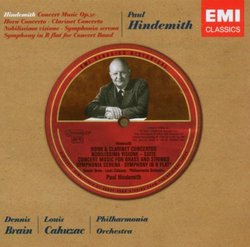 | Paul Hindemith, Philharmonia Orchestra, Louis Cahuzac Hindemith: Concert Music, Op. 50 / Horn Concerto / Clarinet Concerto / Nobilissima visione / Symphonia Serena / Symphony in B flat Major for Concert Band Genre: Classical
|
Larger Image |
CD DetailsSimilarly Requested CDs
|
CD ReviewsVintage Hindemith directed by Hindemith Eckhart H. Richter | 09/02/2007 (5 out of 5 stars) "These two CDs are a re-issue of definitive recordings made in November 1956 at Kingsley Hall in London of six representative orchestral masterpieces by Hindemith, with the composer directing the Philharmonia Orchestra and expertly produced by the legendary Walter Legge. They were first issued between 1957 and 1959 on three single 12 inch LPs under the Angel Records label, not Columbia, as erroneously stated in the record notes. EMI first reissued on CD four of these recorded pieces in 1990, omitting the SYMPHONIA SERENA and the CLARINET CONCERTO written in 1947 for Benny Goodman. The latter work, expertly performed by French clarinetist, Louis Cahuzac, displays an idealy idiomatic treatment of the solo instrument, fully exploiting its varied expressive resources. As a musical masterpiece to boot it is worthy of being ranked with Mozart's standard-setting CONCERTO FOR BASSET CLARINET. As for the SYMPHONIA SERENA, written in 1946 for the Dallas Symphony Orchestra, the author of the record notes sells it altogether too short, characterizing it as "an agreeable work making no pretence of plumbing emotional depths", although he is certainly right in stating that it exploits "various instruments and orchestral groups in an amiable and ingenious way." Far from being emotionally one-dimensional this symphony, with its thematic variety and richness of melodic invention, traverses the gamut of moods that might plausibly be linked with a state of serenity. The majestic calm of the opening theme, spanning a wide melodic arc over the transparent background of muted upper strings transports the listener into an Arcadian musical landscape in turn lyrical, graceful, dreamy, playful, pensive, witty, and tellingly interspersed with hints of indefinable longing. Apart from the pure fun of the second movement, a paraphrase of a GESCHWINDMARSCH by Beethoven, scored here solely for winds, percussion and celesta, this symphony's multilayered expressive content is most plainly evident in the third movement, the COLLOQUY, scored solely for strings. Two contrasting musical panels of equal duration, the opening one, poignantly introspective, played a r c o, the following one marked s c h e r z a n d o and played p i z z i c a t o, vaguely reminiscent of Tchaikovsky's FOURTH SYMPHONY, are then masterfully combined lock, stock and barrel. The three sections are linked by playful cadenzas. the first for two solo violins, the second for two solo violas eventually joined by the two solo violinists, all engaging in a humorously echoing musical dialogue, one member of each pair of soloists being situated backstage. In short this symphony shows the composer in top form. New listerners should not let themselves be scared off by the opening geyser-like eruption of the brilliant CONCERT MUSIC FOR BRASS AND STRINGS, written in 1930 for the 50th anniversary of the Boston Symphony Orchestra. The principal themes simultaneously hured forth at the start sort themselves out in due course with the portentous, magnificently long-breathed s o s t e n u t o theme dominating the concluding section of the piece's opening half. Its second half is brimming with high-spirited music making, cheerfully inserting bows to the classic Blues motive á la Gershwin along the way. A slow, pensive interlude provides a felicitous contrast. The Suite, NOBILISSIMA VISIONE is extracted from the ballet score of the same title. The latter was written for the BALLET RUSSE DE MONTE CARLO and premiered in 1938 in London. Its subject deals with key episodes in the life of St. Francis, its scenario inspired by Giotto's frescoes in Florence's church, SANTA CROCE. While its title alludes to the ballet's subject matter it may be taken as a fitting characterization of the music as well. For here as much as anywhere is realized Hindemith's cherished dream of some day being able to attain the "ideal of a noble music as nearly perfect as possible". The performance of this exalted work under its composer's baton is easily the most loving and sensitive one on record. A special treat is the CONCERTO FOR HORN, wonderfully rendered by the incomparable Dennis Brain, who gave the first performance in 1950 in Baden-Baden, the composer himself conducting. Hindemith subsequently gave Mr. Brain a copy of the full score inscribed "To the unsurpassed original performer of this piece from a grateful composer". It certainly deserves to be placed along with the concertos by Mozart and Strauss into the standard concerto literature for the horn. In conception and design it is easily the most unique among these. The piece is expressively weighted toward the poignant FINALE, at the center of which tne horn declaims, r e c i t a n d o, a short poem in such a way that the note values correspond with the syllables of the German verse, created by the composer, which translates in terms of meaning the nostalgic character of the horn's tone quality. When Hindemith accepted an invitation by the U.S Army Band in Washington, D.C. to be a guest conductor at their concert in February 1950, he suggested that if his appearance could be delayed a bit he "just might write a litllel something". That "little something" premiered under the composer's direction the following April turned out to be the imposing SYMPHONY IN Bb for Concert Band, a veritable t o u r d e f o r c e of contrapuntal wizardy. It is entirely in keeping with the composer's practical, down-to-earth approach that he did not harbor the slightest trace of the condescending attitude toward this medium not uncommon among high-brow classical music aficionados. but rather in a sportsmanly spirit relished the challenge of writiing a weighty symphonic masterpiece for a large American concert band with its daunting array of transposing instruments. Yes, in the hands of a master counterpoint can be immense fun, whether by combining the two main themes of the opening movement and the A n d a n t e g r a z i o s o with the s c h e r z a n d o section of the middle movement or tossing off with incredible panache an ingenious double fugue against which eventually the restatement of this symphony's opening theme serves as an impressive peroration. Musicians' musician, Hindemith was by and large with few exceptions the most convincing interpreter of his work. We are fortunate therefore that with these discussed re-issued performances on the EMI label and the recently re-issued Deutsche Gramophon recordings of Hindemith conducting the Berlin Philharmonic in other of his major masterpieces, also available on Amazon.com, we have preserved for posterity a large portion of the composer's orchestral output under his baton." Hindemith Returns! Michael B. Richman | Portland, Maine USA | 01/20/2007 (5 out of 5 stars) "On the heels of the Original Masters box set Hindemith Conducts Hindemith: The Complete Recordings on Deutsche Grammophon" (see my review), EMI has finally released all of their recordings of composer Paul Hindemith conducting his own music. The vast majority of these performances have been out of the catalog for some time, and collectors have been begging the label to reissue them (thank you!). Now that EMI has finally done so (and so cheaply!), I have finally gotten the chance to hear the Nobilissima Visione Suite, Symphonia Serena, Clarinet Concerto (with soloist Louis Cahuzac) and the Symphony for Concert Band from the composer's own baton, leading the great Philharmonia Orchestra, and to top it off, in glorious golden age stereo -- the DG set as good as it sounds is in mono. These accounts are all outstanding, and in fact are as enjoyable as the two selections that have been available on other titles for several years -- the Horn Concerto with Dennis Brain, which is usually paired with his gorgeous readings of the Strauss Concertos, has always been in print in one form or another, and the Concert Music for Brass and Strings, previously released on the most recent version of that aforementioned Brain CD in the Great Recordings of the Century series (Horn Concertos -- see my review). In all, as I have stated before in other reviews, if you like this composer then the ability to hear him conduct his own music is priceless. Don't pass up the chance to hear Hindemith himself!" A Hindemith release for the 21st Century allemande | Columbia, MO USA | 10/29/2007 (5 out of 5 stars) "As I write this, there are already two very good reviews of this CD set, written by people who obviously appreciate Paul Hindemith. I would like to add a few of my own comments and observations.
First, the sound quality of this release is terrific! As noted by other reviewers, these are all stereo recordings. By the mid-1950s EMI was making very fine recordings in stereo, but it has waited until the last several years for some of those classic recordings to be faithfully transferred to compact discs. The sound here can be described as natural, without undue enhancement of bass or treble frequencies or the harsh, undefined sound so many CDs used to have. Several of these recordings have been sporadically available in the past. EMI released a single disc in 1990, which was the last time the "Symphony in B-Flat" was available. A later two-disc release contained several of the stereo recordings, and included some recordings made for EMI in the 1930s featuring Hindemith performing his own works for solo viola and in a quartet setting. Although those Thirties mono recordings are now out of print, it is bounty to have the stereo ones together in one place and sounding the way they were meant to sound. Perhaps beautiful remasterings of the mono recordings are in the works...? For the uninitiated, Hindemith is a conductor with few idiosyncracies. He directs his own works with amazing detachment, which serves the music well. The two discs in this set contain a lot of music, are priced low, and the arguably definitive recordings sound great. One note of caution: EMI has an unfortunate habit of withdrawing titles quickly and without warning. I would recommend getting this before it becomes unavailable." |

 Track Listings (9) - Disc #1
Track Listings (9) - Disc #1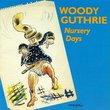
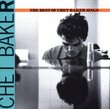
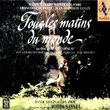
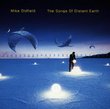

![Seussical [2000 Original Broadway Cast]](https://nationalbookswap.com/cd//m/02/4802/514802.jpg)



